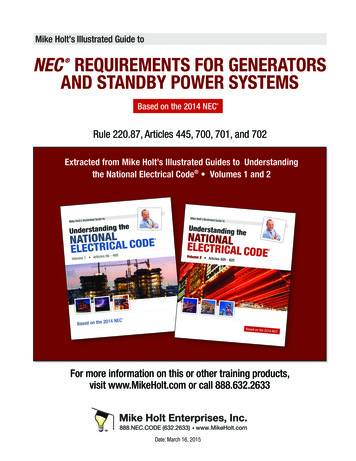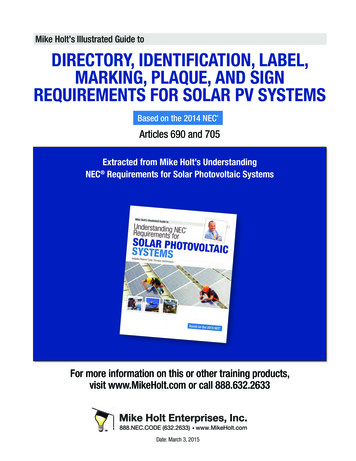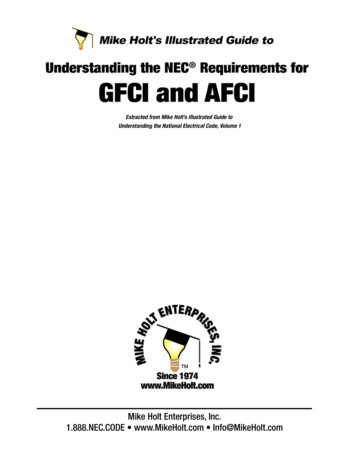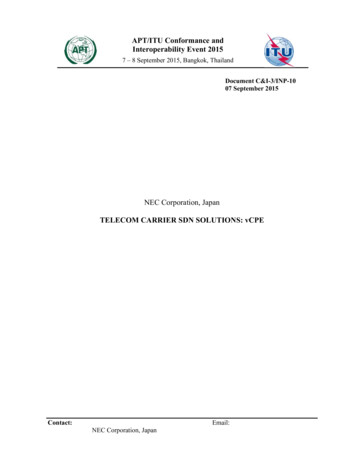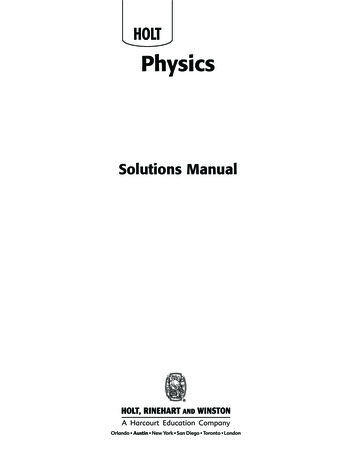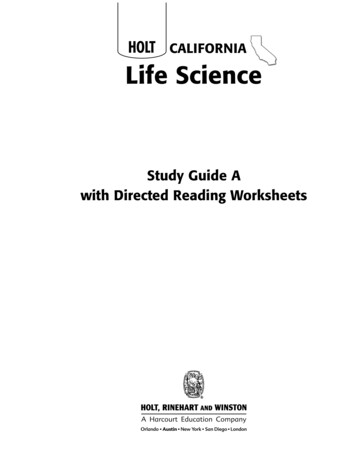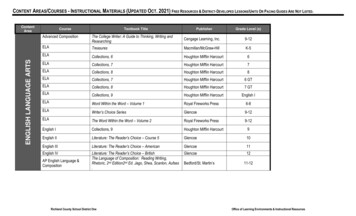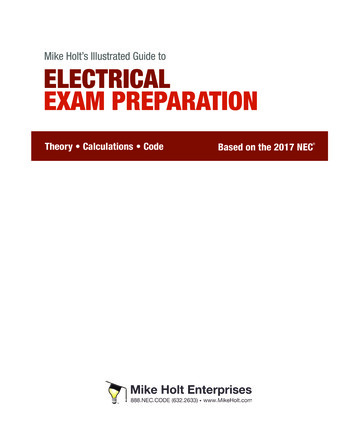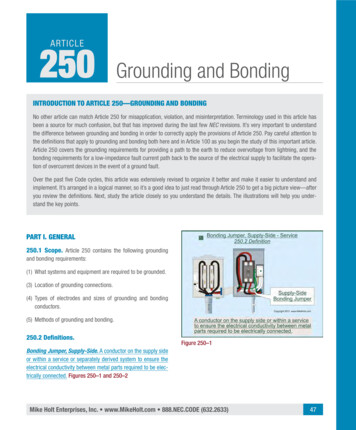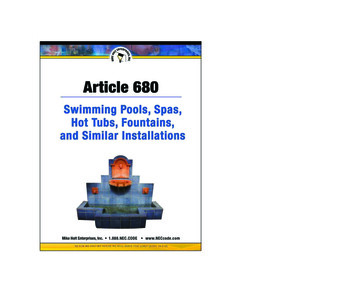
Transcription
Mike Holt's Recommended NEC 2005 IndexFree PDF DownloadIntroductionThis index is a free resource from Mike Holt Enterprises, Inc. You requested it and we produced it! It’sArticle 680 from our Understanding the NEC, Volume 2 textbook. This free resource is for everyone thatwants to focus on Pools, Spas, Hot Tubs, and Fountains.It is always our pleasure to give back to the industry as much as we can, whenever we can and this is aperfect opportunity. If you’re interested in this subject, have a look and please give us your feedback. Asan extra bonus we also included Article 90 – Introduction to the NEC!About the AuthorMike Holt worked his way up through the electrical trade from an apprentice electrician to becomeone of the most recognized experts in the world as it relates to electrical power installation. He was aJourneyman Electrician, Master Electrician, and Electrical Contractor. Mike came from the real world,and his dedication to electrical training is the result of his own struggles as an electrician looking for aprogram that would help him succeed in this challenging industry.It is for reasons like this that Mike continues to help the industry by providing free resources such as thisindex. It is the goal of Mike Holt and everyone on the Mike Holt Team to do everything in our power toaid in your pursuit of excellence.For more great Free resources from Mike Holt visit www.NECcode.comThis article was extracted from Mike’s Understanding the NEC,Volume 2 textbook. To understand the entire National ElectricalCode, you need to study Mike’s Understanding the NEC, Volume 1 &Volume 2textbooks. Volume 1 covers general installationrequirements, branch circuits, feeders, services and overcurrentprotection, grounding versus bonding, conductors, cables andraceways, boxes, panels, motors and transformers, and more, inArticles 90 through 460 (NEC Chapters 1 through 4). Volume 2 coversrequirements for wiring in special occupancies, special equipment,under special conditions, as well as communications systemsrequirements in Articles 500 through 830 (NEC Chapters 5-8).
This textbook is to be used with the NEC, not as a replacementfor the NEC, so be sure to have a copy of the 2005 NationalElectrical Code handy. Compare what Mike has explained in thetext to your Code book, and discuss those topics that you finddifficult to understand with others. As you read through this textbook, be sure to take the time to review the text with the outstanding graphics and examples.fectly clear. When this happens to you, just make it a point tohighlight the section that is causing you difficulty. If you can,take the textbook to someone you feel can provide additionalinsight, possibly your boss, the electrical inspector, a co-worker,your instructor, etc.Cross-ReferencesThis textbook is intended to explain the requirements of theNEC. It isn’t intended to be a replacement for the NEC, so besure you have a copy of the current Code book, and always compare Mike’s explanation, comments, and graphics to the actuallanguage contained in the NEC.The textbook contains thousands of NEC cross-references toother related Code requirements to help you develop a betterunderstanding of how the NEC rules relate to one another. Thesecross-references are identified by a Code Section number inbrackets, such as “90.4,” which would look like “[90.4].”Not an NEC ReplacementThis textbook contains hundreds of “Author’s Comments.” Thesesections were written by Mike to help you better understand theNEC material, and to bring to your attention things he believesyou should be aware of. To help you find them more easily, theyare printed differently than the rest of the material. Mike’s firstAuthor’s Comment is contained in 90.1(B).You’ll sometimes notice that the titles of a few Articles andSections are different than they appear in the actual Code. Thisonly occurs when Mike feels it’s easier to understand the contentof the rule, so please keep this in mind when comparing the twodocuments. For example, 250.8 in the NEC is titled “Connectionof Grounding and Bonding Equipment,” but Mike used the title“Termination of Grounding (Earthing) and BondingConductors,” because he felt his title better reflects the contentof the rule.Textbook FormatTextbook Errors and CorrectionsThis textbook follows the NEC format, but it doesn’t cover everyCode requirement. For example, it doesn’t cover every NECArticle, Section, Subsection, Exception, or Fine Print Note. Sodon’t be concerned if you see that the textbook containsException No. 1 and Exception No. 3, but not Exception No. 2.In addition, at times, the title of an Article, Section, orSubsection might be rephrased differently.Humans develop the text, graphics, and layout of this textbook,and since currently none of us is perfect, there may be a fewerrors. This could occur because the NEC is dramaticallychanged each Code cycle; new Articles are added, some deleted,some relocated, and many renumbered. In addition, this textbookmust be written within a very narrow window of opportunity;after the NEC has been published (September), yet before it’senforceable (January).Author’s CommentsDifficult ConceptsAs you progress through this textbook, you might find that youdon’t understand every explanation, example, calculation, orcomment. Don’t get frustrated, and don’t get down on yourself.Remember, this is the National Electrical Code and sometimesthe best attempt to explain a concept isn’t enough to make it per-You can be sure we work a tremendous number of hours and useall of our available resources to produce the finest product withthe fewest errors. We take great care in researching the Coderequirements to ensure this textbook is correct. If you feel there’san error of any type in this textbook (typo, grammar, or technical), no matter how insignificant, please let us know.xxi
How to Use This TextbookAny errors found after printing are listed on our Website, so ifyou find an error, first check to see if it has already been corrected. Go to www.MikeHolt.com, click on the “Books” link,and then the “Corrections” link (www.MikeHolt.com/bookcorrections.htm).If you do not find the error listed on the Website, contact us byE-mailing corrections@MikeHolt.com, calling 1.888.NEC.CODE(1.888.632.2633), or faxing 954.720.7944. Be sure to include thebook title, page number, and any other pertinent information.InternetToday as never before, you can get yourtechnical questions answered by postingthem to Mike Holt’s Code Forum. Justvisit www.MikeHolt.com and clickon the “Code Forum” link.xxiiUnderstanding the National Electrical Code, Volume 1Different InterpretationsSome electricians, contractors, instructors, inspectors, engineers,and others enjoy the challenge of discussing the Code requirements, hopefully in a positive and a productive manner. Thisaction of challenging each other is important to the process ofbetter understanding the NEC’s requirements and its intendedapplication. However, if you’re going to get into an NEC discussion, please do not spout out what you think without having theactual Code in your hand. The professional way of discussing anNEC requirement is by referring to a specific section, rather thanby talking in vague generalities.
The National Electrical Code (NEC) is written for persons whounderstand electrical terms, theory, safety procedures, and electrical trade practices. These individuals include electricians,electrical contractors, electrical inspectors, electrical engineers,designers, and other qualified persons. The Code was not writtento serve as an instructive or teaching manual for untrained individuals [90.1(C)].Learning to use the NEC is somewhat like learning to play thegame of chess; it’s a great game if you enjoy mental warfare. Youmust first learn the names of the game pieces, how the pieces areplaced on the board, and how each piece moves.In the electrical world, this is equivalent to completing a comprehensive course on basic electrical theory, such as: What electricity is and how is it produced Dangers of electrical potential: fire, arc blast, arcfault, and electric shock Direct current Series and parallel circuits Electrical formulas Alternating current Induction, motors, generators, and transformersOnce you understand the fundamentals of the game of chess,you’re ready to start playing the game. Unfortunately, at thispoint all you can do is make crude moves, because you really donot understand how all the information works together. To playchess well, you will need to learn how to use your knowledge byworking on subtle strategies before you can work your way up tothe more intriguing and complicated moves.Again, back to the electrical world, this is equivalent to completing a course on the basics of electrical theory. You have thefoundation upon which to build, but now you need to take it tothe next level, which you can do by reading this textbook,watching the companion video or DVD, and answering the NECpractice questions in the Workbook to AccompanyUnderstanding the National Electric Code, Volume 1.Not a GameElectrical work isn’t a game, and it must be taken very seriously.Learning the basics of electricity, important terms and concepts,as well as the basic layout of the NEC gives you just enoughknowledge to be dangerous. There are thousands of specific andunique applications of electrical installations, and the Codedoesn’t cover every one of them. To safely apply the NEC, youmust understand the purpose of a rule and how it affects thesafety aspects of the installation.NEC Terms and ConceptsThe NEC contains many technical terms, so it’s crucial that Codeusers understand their meanings and their applications. If you donot understand a term used in a Code rule, it will be impossibleto properly apply the NEC requirement. Be sure you understandthat Article 100 defines the terms that apply to two or moreArticles. For example, the term “Dwelling Unit” applies to manyArticles. If you do not know what a Dwelling Unit is, how canyou possibly apply the Code requirements for it?In addition, many Articles have terms that are unique for thatspecific Article. This means that the definition of those terms isonly applicable for that given Article. For example, Article 250Grounding and Bonding has the definitions of a few terms thatare only to be used within Article 250.Small Words, Grammar, and PunctuationIt’s not only the technical words that require close attention,because even the simplest of words can make a big difference tothe intent of a rule. The word “or” can imply alternate choicesfor equipment wiring methods, while “and” can mean an additional requirement. Let’s not forget about grammar and punctuation. The location of a comma “,” can dramatically change therequirement of a rule.Slang Terms or Technical JargonElectricians, engineers, and other trade-related professionals useslang terms or technical jargon that isn’t shared by all. Thismakes it very difficult to communicate because not everybodyxxiii
The National Electrical Codeunderstands the intent or application of those slang terms. Sowhere possible, be sure you use the proper word, and do not usea word if you do not understand its definition and application.For example, lots of electricians use the term “pigtail” whendescribing the short conductor for the connection of a receptacle,switch, luminaire, or equipment. Although they may understandit, not everyone does. Figure 1Understanding the National Electrical Code, Volume 12. Chapters. There are nine Chapters, each of which is dividedinto Articles. The Articles fall into one of four groupings:General Requirements (Chapters 1 through 4), Specific Requirements (Chapters 5 through 7), Communications Systems(Chapter 8), and Tables (Chapter 9). Chapter 1 GeneralChapter 2 Wiring and ProtectionChapter 3 Wiring Methods and MaterialsChapter 4 Equipment for General UseChapter 5 Special OccupanciesChapter 6 Special EquipmentChapter 7 Special ConditionsChapter 8 Communications Systems (Telephone,Data, Satellite, and Cable TV) Chapter 9 Tables—Conductor and RacewaySpecifications3. Articles. The NEC contains approximately 140 Articles, eachof which covers a specific subject. For example:Figure 1NEC Style and LayoutBefore we get into the details of the NEC, we need to take a fewmoments to understand its style and layout. Understanding thestructure and writing style of the Code is very important beforeit can be used effectively. If you think about it, how can you usesomething if you don’t know how it works? Okay, let’s getstarted. The National Electrical Code is organized into ninecomponents. Table of ContentsChapters 1 through 9 (major categories)Articles 90 through 830 (individual subjects)Parts (divisions of an Article)Sections and Tables (Code requirements)Exceptions (Code permissions)Fine Print Notes (explanatory material)IndexAnnexes (information)1. Table of Contents. The Table of Contents displays the layoutof the Chapters, Articles, and Parts as well as the page numbers.It’s an excellent resource and should be referred to periodicallyto observe the interrelationship of the various NEC components.When attempting to locate the rules for a particular situation,knowledgeable Code users often go first to the Table of Contentsto quickly find the specific NEC section that applies.xxiv Article 110 General RequirementsArticle 250 GroundingArticle 300 Wiring MethodsArticle 430 MotorsArticle 500 Hazardous (Classified) LocationsArticle 680 Swimming Pools, Spas, Hot Tubs, andFountains Article 725 Remote-Control, Signaling, and PowerLimited Circuits Article 800 Communications Systems4. Parts. Larger Articles are subdivided into Parts. For example,Article 110 has been divided into multiple parts: Part I. General (Sections 110.1—110.23) Part II. 600 Volts, Nominal, or Less (110.26—110.27) Part III. Over 600 Volts, Nominal (110.30—110.59)Note: Because the Parts of a Code Article aren’t included in theSection numbers, we have a tendency to forget what “Part” theNEC rule is relating to. For example, Table 110.34(A) containsthe working space clearances for electrical equipment. If wearen’t careful, we might think this table applies to all electricalinstallations, but Table 110.34(A) is located in Part III, whichcontains the requirements for Over 600 Volts, Nominal installations. The rules for working clearances for electrical equipmentfor systems 600V or less are contained in Table 110.26(A)(1),which is located in Part II. 600 Volts, Nominal, or Less.5. Sections and Tables.Sections: Each NEC rule is called a Code Section. A CodeSection may be broken down into subsections by letters in parentheses (A), (B), etc. Numbers in parentheses (1), (2), etc., may
Understanding the National Electrical Code, Volume 1The National Electrical Codefurther break down a subsection, and lower-case letters (a), (b),etc., further breaks the rule down to the third level. For example,the rule requiring all receptacles in a dwelling unit bathroom tobe GFCI protected is contained in Section 210.8(A)(1). Section210.8(A)(1) is located in Chapter 2, Article 210, Section 8, subsection (A), sub-subsection (1).Note: Changes to the NEC, since the previous edition(s) areidentified in the margins by a vertical line ( ), but rules that havebeen relocated aren’t identified as a change. In addition, the location from which the Code rule was removed has no identifier.Many in the industry incorrectly use the term “Article” whenreferring to a Code Section. For example, they say “Article210.8,” when they should say “Section 210.8.”How to go about finding what you’re looking for in the Codedepends, to some degree, on your experience with the NEC.Code experts typically know the requirements so well that theyjust go to the NEC rule without any outside assistance. The Tableof Contents might be the only thing very experienced Code usersneed to locate their requirement. On the other hand, averageCode users should use all of the tools at their disposal, and thatincludes the Table of Contents and the Index.Tables: Many Code requirements are contained within Tables,which are lists of NEC requirements placed in a systematicarrangement. The titles of the Tables are extremely important;they must be carefully read in order to understand the contents,applications, limitations, etc., of each Table in the Code. Manytimes notes are provided in a table; be sure to read them as well,since they are also part of the requirement. For example, Note 1for Table 300.5 explains how to measure the cover when buryingcables and raceways, and Note 5 explains what to do if solid rockis encountered.6. Exceptions. Exceptions are Code requirements that providean alternative method to a specific requirement. There are twotypes of exceptions—mandatory and permissive. When a rulehas several exceptions, those exceptions with mandatory requirements are listed before the permissive exceptions.Mandatory Exception: A mandatory exception uses the words“shall” or “shall not.” The word “shall” in an exception meansthat if you’re using the exception, you’re required to do it in aparticular way. The term “shall not” means it isn’t permitted.Permissive Exception: A permissive exception uses words such as“is permitted,” which means that it’s acceptable to do it in this way.7. Fine Print Note (FPN). A Fine Print Note contains explanatorymaterial intended to clarify a rule or give assistance, but it isn’ta Code requirement.8. Index. The Index contained in the NEC is excellent and ishelpful in locating a specific rule.9. Annexes. Annexes aren’t a part of the NEC requirements, andare included in the Code for informational purposes only. Annex A. Product Safety Standards Annex B. Application Information for AmpacityCalculation Annex C. Conduit and Tubing Fill Tables forConductors and Fixture Wires of the Same Size Annex D. Examples Annex E. Types of Construction Annex F. Cross-Reference Tables (1999, 2002, and2005 NEC) Annex G. Administration and EnforcementHow to Locate a Specific RequirementTable of Contents: Let’s work out a simple example: What NECrule specifies the maximum number of disconnects permitted fora service? If you’re an experienced Code user, you’ll know thatArticle 230 applies to “Services,” and because this Article is solarge, it’s divided up into multiple parts (actually 8 parts). Withthis knowledge, you can quickly go to the Table of Contents (page70-2) and see that it lists the Service Equipment DisconnectingMeans requirements in Part VI, starting at page 70-77.Note: The number 70 precedes all page numbers because the NECis standard number 70 within the collection of NFPA standards.Index: If you used the Index, which lists subjects in alphabeticalorder, to look up the term “service disconnect,” you would seethat there’s no listing. If you tried “disconnecting means,” then“services,” you would find the Index specifies that the rule islocated at 230, Part VI. Because the NEC doesn’t give a pagenumber in the Index, you’ll need to use the Table of Contents toget the page number, or flip through the Code to Article 230, thencontinue to flip until you find Part VI.As you can see, although the index is verycomprehensive, it’s not that easy to use ifyou do not understand how the indexworks. But if you answer the over 1,200NEC practice questions or seven 50question exams contained in theWorkbook to Accompany Understandingthe National Electric Code, Volume 1,you’ll become a master at findingthings in the Code quickly.Many people complain that the NEC only confuses them bytaking them in circles. As you gain experience in using the Codeand deepen your understanding of words, terms, principles, andpractices, you will find the NEC much easier to understand anduse than you originally thought.xxv
The National Electrical CodeUnderstanding the National Electrical Code, Volume 1Customizing Your Code BookUnderlining: Underline or circle key words and phrases in theOne way to increase your comfort level with the Code is to customize it to meet your needs. You can do this by highlighting andunderlining important NEC requirements, and by attaching tabsto important pages.NEC with a red pen (not a lead pencil) and use a 6-in. ruler tokeep lines straight and neat. This is a very handy way to makeimportant requirements stand out. A small 6-in. ruler also comesin handy for locating specific information in the many Codetables.Highlighting: As you read through this textbook and answer thequestions in the workbook, be sure you highlight those requirements in the Code that are most important to you. Use yellow forgeneral interest and orange for important requirements you wantto find quickly. Be sure to highlight terms in the Index and Tableof Contents as you use them.Because of the size of the 2005 NEC, I recommend you highlight in green the Parts of Articles that are important for yourapplications, particularly:Article 230 ServicesArticle 250 GroundingArticle 430 MotorsxxviTabbing the NEC: Placing tabs onimportant Code Articles, Sections, andTables will make it very easy toaccessimportantNECrequirements. However, toomany tabs will defeat the purpose. You can order a customset of Code tabs, designed byMikeHolt,onlineatwww.MikeHolt.com, or bycalling us at 1.888.NEC.Code(1.888.632.2633).
Many NEC violations and misunderstandings wouldn’t occur if people doing the work simply understood Article 90. For example, manypeople see Code requirements as performance standards. In fact, NEC requirements are the bare minimum for safety. This is exactly thestance electrical inspectors, insurance companies, and courts will take when making a decision regarding electrical design or installation.Article 90 opens by saying the NEC isn’t intended as a design specification or instruction manual. The National Electrical Code has one purpose only. That is “the practical safeguarding of persons and property from hazards arising from the use of electricity.”Article 90 then describes the scope and arrangement of the Code. A person who says, “I can’t find anything in the Code,” is really saying,“I never took the time to review Article 90.” The balance of Article 90 provides the reader with information essential to understanding thoseitems you do find in the NEC.Typically, electrical work requires you to understand the first four Chapters of the NEC, plus have a working knowledge of the Chapter 9tables. Chapters 5, 6, 7, and 8 make up a large portion of the NEC, but they apply to special situations. They build on, and extend, what youmust know in the first four chapters. That knowledge begins with Chapter 1.90.1 Purpose of the NEC.(A) Practical Safeguarding. The purpose of the NEC is toensure that electrical systems are installed in a manner that protects people and property by minimizing the risks associatedwith the use of electricity.(B) Adequacy. The Code contains requirements that are considered necessary for a safe electrical installation. When an electrical installation is installed in compliance with the NEC, it willbe essentially free from electrical hazards. The NEC is a safetystandard, not a design guide.The NEC requirements aren’t intended to ensure that the electrical installation will be efficient, convenient, adequate for goodservice, or suitable for future expansion. Specific items of concern, such as electrical energy management, maintenance, andpower quality issues aren’t within the scope of the NEC.Figure 90–1Figure 90–11
Understanding the National Electrical Code, Volume 190.1FPN: Hazards in electrical systems often occur because circuits areoverloaded or not properly installed in accordance with the NEC. Theinitial wiring often did not provide reasonable provisions for systemchanges or for the increase in the use of electricity.Author’s Comments: See Article 100 for the definition of “Overload.” The NEC does not require electrical systems to be designedor installed to accommodate future loads. However, theelectrical designer, typically an electrical engineer, is concerned with not only ensuring electrical safety (Code compliance), but also ensuring that the system meets the customers’ needs, both of today and in the near future. To satisfy customers’ needs, electrical systems must be designedand installed above the minimum requirements containedin the NEC.(C) Intention. The Code is to be used by those skilled andknowledgeable in electrical theory, electrical systems, construction, and the installation and operation of electrical equipment. Itisn’t a design specification standard or instruction manual for theuntrained and unqualified.(D) Relation to International Standards. The requirements ofthe NEC address the fundamental safety principles contained inInternational Electrotechnical Commission standards, includingprotection against electric shock, adverse thermal effects, overcurrent, fault currents, and overvoltage. Figure 90–2Author’s Comments: See Article 100 for the definition of “Overcurrent.” The NEC is used in Chile, Ecuador, Peru, and the Philippines.It’s also the Electrical Code for Colombia, Costa Rica, Mexico,Panama, Puerto Rico, and Venezuela. Because of these adoptions, the NEC is available in Spanish from the National FireProtection Association, 1.617.770.3000.Figure 90–390.2 Scope of the NEC.(A) What is Covered. The NEC contains requirements necessary for the proper electrical installation of electrical conductors,equipment, and raceways; signaling and communications conductors, equipment, and raceways; as well as fiber optic cablesand raceways for the following locations: Figure 90–3(1) Public and private premises, including buildings or structures, mobile homes, recreational vehicles, and floatingbuildings.(2) Yards, lots, parking lots, carnivals, and industrial substations.(3) Conductors and equipment that connect to the utility supply.(4) Installations used by an electric utility, such as office buildings, warehouses, garages, machine shops, recreationalbuildings, and other electric utility buildings that are not anintegral part of a utility’s generating plant, substation, or control center. Figure 90–4(B) What isn’t Covered. The National Electrical Code doesn’tapply to the following applications:(1) Transportation Vehicles. Installations in cars, trucks, boats,ships and watercraft, planes, electric trains, or undergroundmines.(2) Mining Equipment. Installations underground in mines andself-propelled mobile surface mining machinery and its attendant electrical trailing cables.(3) Railways. Railway power, signaling, and communicationswiring.Figure 90–22(4) Communications Utilities. The installation requirements ofthe NEC do not apply to communications (telephone), CATV, ornetwork-powered broadband utility equipment located in
Understanding the National Electrical Code, Volume 190.2Figure 90–6Figure 90–4building spaces used exclusively for such use or outdoors, if theinstallation is under the exclusive control of the communicationsutility. Figure 90–5Author’s Comment: Interior wiring for communications systems, not in building spaces used exclusively for such use, mustbe installed in accordance with the following Chapter 8 requirements: Figure 90–6 Phone and Data, Article 800 CATV, Article 820 Network-Powered Broadband, Article 830Figure 90–5(5) Electric Utilities. The NEC doesn’t apply to electric installations under the exclusive control of an electric utility where suchinstallations:a. Consist of service drops or service laterals and associatedmetering. Figure 90–07b. Are located on legally established easements, rights-ofway, or by other agreements recognized by public/utilityregulatory agencies, or property owned or leased by theelectric utility. Figure 90–8c. Are on property owned or leased by the electric utility for thepurpose of generation, transformation, transmission, distribution, or metering of electric energy. See Figure 90–8.Author’s Comment: Luminaires (lighting fixtures) located inlegally established easements, or rights-of-way, such as at polessupporting transmission or distribution lines, are exempt from therequirements of the NEC. However, if the electric utility providesFigure 90–73
Understanding the National Electrical Code, Volume 190.2Figure 90–8site and public lighting on private property, then the installationmust comply with the NEC [90.2(A)(4)]. Figure 90–9FPN to 90.2(B)(4) and (5): Utilities include entities thatinstall, operate, and maintain communications systems (telephone, CATV, Internet, satellite, or data services) or electricsupply systems (generation, transmission, or distribution systems) and are designated or recognized by governmental lawor regulation by public service/utility commissions. Utilitiesmay be subject to compliance with codes and standards covering their regulated activities as adopted under governmentallaw or regulation.Figure 90–1090.3 Code Arrangement. The Code is divided into anIntroduction and nine chapters. Figure 90–10General Requirements. The requirements contained in Chapters1, 2, 3, and 4 apply to all installations.Author’s Comment: The scope of this textbook includes NECChapters 1 through 4.Special Requirements. The requirements contained in Chapters5, 6, and 7 apply to special occupancies, special equipment, orother special conditions. They can supplement or modify therequirements in Chapters 1 through 4.Figure 90–94For example, the general requirement contained in 250.118 ofArticle 250 Grounding and Bonding states that a metal raceway,such as Electrical Metallic Tubing, is considered suitable to provide a low-impedance path to the power supply for ground-faultcurrent. However, 517.13(B) of Article 517 Health CareFacilities doesn’t consider the raceway to be sufficient. Itrequires an insulated copper conductor to be installed in theraceway for this purpose.
Understanding the National Electrical Code, Volume 1Communications Systems. Chapter 8 contains the requirementsfor commun
For more great Free resources from Mike Holt visit www.NECcode.com This article was extracted from Mike's Understanding the NEC, Volume 2 textbook. To understand the entire National Electrical Code, you need to study Mike's Understanding the NEC, Volume 1 & Volume 2 textbooks. Volume 1 covers general installation
